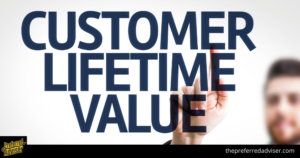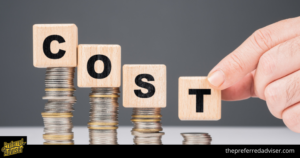If your customers can’t figure out how to use your product, they’re not going to buy it. This is especially important for companies that sell software as a service (SaaS), because customers often have to explore the product on their own without getting help from a salesperson or customer service representative.
If customers are successful with your product, they’re more likely to keep using it and recommend it to others who need a similar solution.
Most Important Customer Success Metrics
What are the metrics you use to determine whether your customers are successful? The eight most important customer success metrics for SaaS companies are provided below, along with information on how to measure them.
1. Customer Lifetime Value
 CLV is the total amount of money a customer is expected to spend with a company over the duration of their relationship. This method of measuring customer success is very effective in determining how successful customer success efforts are in relation to revenue.
CLV is the total amount of money a customer is expected to spend with a company over the duration of their relationship. This method of measuring customer success is very effective in determining how successful customer success efforts are in relation to revenue.
Customer lifetime value brings together the impact your customer success operation has on two key performance indicators:
- Annual revenue per customer
- Average length of customer relationship (in years)
An effective customer success team should help your business increase sales and reduce customer churn, leading to improved customer lifetime value.
Calculating Customer Lifetime Value
To calculate your average customer lifetime value, you’ll need three pieces of data:
- Annual revenue per customer
- Customer relationship in years
- Customer acquisition cost (CAC)
To calculate your customer lifetime value, take your annual revenue per customer and multiply it by the customer relationship in years, then subtract your customer acquisition cost. The result is your average customer lifetime value.
2. Repeat Purchase Rate
The best way to measure how successful and satisfied your customers are is by how often they continue to do business with you. After their contract is up, do they renew? Do your customers return to your business to purchase your product again, or do they go to one of your competitors instead?
The RPR indicates how many customers are making repeat purchases, which is an indication of how successful customer success efforts are.
Calculating Repeat Purchase Rate
To calculate your repeat purchase rate, you’ll need two numbers on hand:
- The number of customers who returned to make another purchase over a given period of time.
- The total number of customers you have had over the same time period.
The numbers mentioned, as well as the repeat purchase rate, are generally calculated using yearly figures. However, you can assess them using any time frame that is practical for your company.
To calculate your repeat customer rate, take the number of customers who made a repeat purchase during your chosen time period and divide it by the total number of customers you had during that same time period.
3. Customer Retention Rate
The customer retention rate refers to the percentage of customers who continue to use a company’s product or service over a period of time. Companies with more ongoing customer relationships tend to have higher customer retention rates.
Your customer retention rate is a measurement of the percentage of your current customers that your business was able to keep over a given period of time. How many of your customers stay with you from one month to the next, or from one quarter to the next year?
Calculating Customer Retention Rate
To calculate customer retention rate, you’ll need to know three pieces of information:
- compared to the number of customers you have at the end of that period The number of customers you had at the beginning of a given period of time compared to the number of customers you have at the end of that period
- The number of customers you had by the end of that period
- How many new customers you gained during that time period.
To calculate customer churn rate, you will first subtract the number of newly acquired customers from the total number of customers you had at the end of the specified time period. Then, you will divide that number by the number of customers you had at the beginning of that time period.
To calculate your customer retention rate, divide the number of customers you retained during a period by the number of customers you had at the beginning of that period. Then, multiply your answer by 100 to get the percentage that is your customer retention rate.
4. Customer Retention Cost
 CRC measures the amount of money your company needs to spend in order to keep each customer. Measuring this customer success metric is useful in a few ways:
CRC measures the amount of money your company needs to spend in order to keep each customer. Measuring this customer success metric is useful in a few ways:
- The impact of customer success on customer retention can be measured by how much the retention rate grows in proportion to the costs of running the customer success team.
- This allows you to see if the value of your customers justifies the money you spend on customer success and retention.
CRC is a way to measure if your customer success efforts are effective.
Calculating Customer Retention Cost
To calculate customer retention cost, you’ll need two pieces of data:
- is $120,000 The annual cost for customer success and retention teams and initiatives is $120,000.
- The number of current active customers
To calculate your company’s customer lifetime value, divide the total annual cost by the number of active customers. The answer (in dollars) is your customer retention cost
5. Churn Rate
Churn rate is a measure of customer retention. Looking at churn from a different perspective can help you better understand your customer base. Churn measures how many customers you lose over a given time period, rather than customers you retain.
There is no one-size-fits-all answer when it comes to measuring churn, as the complexity of the metric can be adapted to suit your specific needs. Churn is mainly calculated by looking at either how many customers are lost, or how much money those customers are worth.
Although it may seem easy enough, measuring customer turnover in a way that is helpful businesses requires a specific and detailed definition of what a “lost” customer looks like. This will differ from business to business.
Calculating Churn Rate
Churn rate is defined as the percentage of customers who stopped using a company’s products or services during a certain period of time. You’ll need to know:
- At the beginning of the time period, how many customers did you have?
- How many customers churned during the same period
There, divide the number of customers who churned by your original number. Then, multiply that number by one hundred to find the percentage of customers who have churned. The result is your churn rate.
6. Net Promoter Score
NPS is a different kind of customer success metric than the ones we’ve talked about before. This company uses customer feedback and voice of customer data to inform their decisions.
The Net Promoter Score has exploded in popularity in recent years, and even if you haven’t used it as a customer success professional, you’ve probably experienced it as a consumer.
Your Net Promoter Score (NPS) is a customer satisfaction metric that is based on responses to an NPS survey. The survey includes a single question that is next to a 10-point scale. The question asks respondents how likely they would be to recommend the business or product to a friend.
- Customers who give a number between 7 and 8 are called “passives.” Customers who give a number between 9 and 10 are called “promoters.” Customers who respond with a number between 0 and 6 are considered to be “detractors.” Customers who give a number between 7 and 8 are considered to be “passives.” Customers who give a number between 9 and 10 are considered to be “promoters.”
- Those who respond with 7 or 8 are “passives.”
- Respondents who choose 9 or 10 are your “promoters.”
Calculating Net Promoter Score
 Net Promoter Scores vary between -100 and +100. Your NPS is the difference between the percentage of customers who are promoters and the percentage of customers who are detractors.
Net Promoter Scores vary between -100 and +100. Your NPS is the difference between the percentage of customers who are promoters and the percentage of customers who are detractors.
NPS = % Promoters – % Detractors
Note: NPS metrics are expressed as a number, not a percentage.
7. Customer Health Score
It is important to not just focus on individual tickets or emails and to step back and look at the big picture. This is the question you need to answer. You need to determine whether your customers are seeing value in your product or service.
How often is your customer using the product? What percentage of your customers are successful after purchasing your product? What effect does it have on their business? Has their pain point been eliminated?
Customer support is no longer just about getting someone to sign up for a new service, or answering their emails and calls. It’s now about creating a lasting relationship with the customer.
Reps should aim to ensure that their customers are not only surviving but also thriving after their purchase. They need to stay in touch with customers, give help with any issues, and help plan for the future.
Kate Forrester from the Forrester blog points out that customer success is key to increasing revenue from existing customers and influencing new sales.
One person’s success with your product can lead another person to try it in hopes of achieving a similar outcome. This virtuous cycle only occurs when you actively encourage and track customer success.
Calculating Customer Health Score
To measure customer success, formulate a customer “health” score. What do their finances look like? How many customers do they have? Make sure you understand how your product affects their business, then keep track of that metric to see how it changes.
A customer health score can be developed by compiling all of the available data and using an index to track the progress.
You can also measure your customers’ growth. The success of a business is best indicated by its growth. In order to gauge how successful a customer is becoming, you can ask if the company is hiring, taking on more business, or improving customer retention rates.
8. Qualitative Customer Feedback
Another important thing to measure is your customers’ feedback. What do people think about you and the service you offer? What are the benefits and drawbacks of their connection to the company?
Customers need to feel that they have a voice. Asking for their feedback and input is a great way to build a long-term and significant relationship.
Customer success managers can determine from qualitative feedback, such as survey responses, how well their reps are working with clients.
It’s never fun to hear where your company is going wrong, but it’s important to have the chance to fix the problem before the customer leaves.
Calculating Qualitative Customer Feedback
The easiest method for gathering customer feedback is to administer a survey. What are a few questions you could ask your customer base about your customer support reps?
You could also invite some customers to your office or headquarters for lunch or a meeting, and talk to them one-on-one. Observe the facial expressions and body language of the people you talk to when they reflect on the service they received and how they would improve their experience.
Customer feedback is not only about the product but also about the clients’ feeling about the brand and company.
9. Monthly Recurring Revenue
Monthly recurring revenue is a great metric for determining how much your customer base or their spending has grown since working with your business.
This metric outlines how much money your customers are spending on your products and services each month. This value can be compared over time to determine whether customers are succeeding with your products.
This can be especially helpful for businesses that offer software as a service on a subscription basis.
You can also calculate your expansion MRR, which is another MRR metric. The expansion monthly recurring revenue (MRR) tells you how much more revenue you’re making from customers who are not subscribed to your monthly service.
You can get a good idea of how effective your upgrades and customer loyalty programs are by looking at how much revenue they bring in.
Calculating Monthly Recurring Revenue
 Multiplying your total monthly active customers by your average revenue per user will give you your monthly recurring revenue. This will give you an idea of how much money you generate each month.
Multiplying your total monthly active customers by your average revenue per user will give you your monthly recurring revenue. This will give you an idea of how much money you generate each month.
I can calculate my monthly recurring revenue by multiplying my average revenue per customer by my number of monthly active customers.
To calculate expansion MRR, you’ll need to add up all revenue that was generated from customers who made a purchase in addition to their normal recurring purchase. Other possible sales to customers could include loyalty programs and add-ons that they purchase on a one-time basis.
By calculating the total amount spent on premium offers, you can get an estimate of your customers’ total spending. If you’re doing well, then your customers are not only enjoying your product or service but are thriving because of it.
10. First Contact Resolution Rate
One of the most common customer needs is time. Customers want their problems solved as soon as possible so that they can focus on their goals again. If customers are constantly waiting for your support team, this makes the customer experience much worse.
It is important to measure your rate of resolving customer issues on the first contact. This is the percentage of customer service cases that are resolved on the first try.
The higher this number is, the better it is for your team. This means they are responding to customer needs promptly.
Measuring First Contact Resolution Rate
First contact resolution rate is calculated by dividing the number of service tickets closed after the first interaction by the total number of service cases received.
This can be done by using customer service tools to help you keep track of incoming cases. A ticketing system can create digital records of your cases that are easy to categorize and store.
A help desk can provide you with the tools you need to calculate your first contact resolution rate without having to do the calculations yourself.
Conclusion
How your company does customer-wise will determine how successful it is. If your customers are satisfied with the value they receive from your products, then you will likely see an increase in revenue and market share.
The only way to know if they are successful is to measure their success. The metrics, dashboards, and tips in the text can help you improve your customer success strategy and achieve success in your business.

0 comments